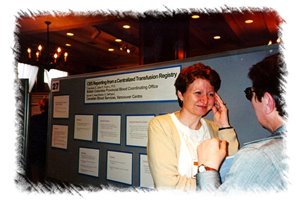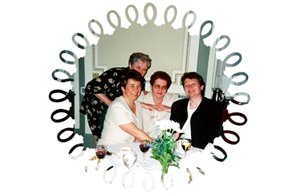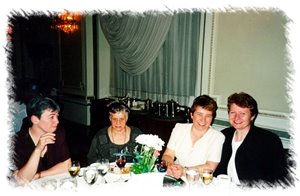The CSTM is very excited to introduce a new feature on our Blog! Pat Letendre has agreed to write a series of blogs recognizing our colleagues in Canadian Transfusion Medicine.
Many of you will know Pat from her extensive involvement in Transfusion Medicine in Canada. Pat was a long-time instructor in transfusion science at the University of Alberta, an early adopter of the Internet's potential for professional development, the CSTM webmaster (2001 - 2010), the PBCO TraQ webmaster and a strong believer in the joy of life-long learning. The CSTM have an annual bursary in Pat's honour.
Pat's contacts in the Canadian TM world and her well-known blogging skills made her the perfect choice to write this series. We look forward to Pat's posts and invite you to comment and discuss her blogs. As well, we welcome anyone else as a guest blogger - if you would like to contribute a blog post, please contact [email protected].
And now - here's Pat!
It's my pleasure, indeed an honour, to write a series of blogs for CSTM to celebrate the careers of transfusion professionals who came before and made a difference. Some names you may recognize, some you may not. But rest assured these diverse individuals all made a difference and we are the better for it.
Each blog begins with my musings on the individual, followed by a brief background on the person's career, sometimes with my comments throughout. If you're looking for a rah-rah, rosy view of Canada's transfusion medicine field, this ain't it. Why? Although all participants enjoyed their careers and love the transfusion profession, they also speak honestly about both the ups and downs. Perhaps their reflections will resonate with your experiences.
I will remember you: Kathy Chambers
This blog features Kathy Chambers, a medical laboratory technologist I met after moving to Edmonton in 1977 to become the transfusion science instructor in MLS, University of Alberta, where I taught both MLS and NAIT students doing a clinical rotation at UAH. Kathy and I got to know each other better when she became the senior technologist responsible for overseeing med lab technologist clinical rotations in the UAH blood bank. When she decided to do an ART in transfusion science, she asked me to review her literature review, and I was glad to do so.
Over the ensuing 35 years+, Kathy and I collaborated on many projects. Three examples:
In the early 2000s, I worked with Kathy when she consulted for the BC PBCO, Canada's first provincial blood coordinating office, whose Technical Resource Manual and Competency Companion served as templates for so many provincial blood coordinating offices and equivalents that followed. I'd landed a dream job as TraQ webmaster, thanks to Kathy recommending me to Dr. David Pi, the then BC PBCO medical director, at CSTM 2000 in Quebec City.
During 2000-3, Kathy and I created a CBS educational website <www.transfusionmedicine.ca> from scratch with our content vetted by Dr. Heather Hume (whose vision it was), with help from Dr. Cindy Whitman. The site transmogrified over the years and our vein-to-vein sections no longer exist as they are apparently too time intensive to update. Working on this website with Kathy was a joy and I learned much.
In 2007 I was part of a team of technologists who replied to an Alberta Health RFP to develop a blood contingency plan. Kathy ended up as co-lead because she had the drive, skills and knowledge to make it happen. Eventually, the project became one of many resources used to create Alberta's blood contingency plan. The team had many unexpected ups-and-downs but Kathy was the glue that kept us together.
To me, Kathy Chambers is a force of nature, the most efficient worker I've ever seen, a can-do person whose quality of work is invariably outstanding.
BACKGROUND
Before you can truly appreciate how Kathy made a difference and understand her musings, you should know more about her experiences. For a few of Kathy's many contributions to Canada's transfusion community, see a short resume.
KATHY'S MUSINGS
Accomplishments?
Managing a team of smart, empowered women who made the transfusion service as good when I was not there as when I was. This happened at RCH in New Westminster. From designing a new lab, working in less than good circumstances (interim lab was built in a less than ideal storage space, which sometimes caused friction, but the team handled it well), moving into the new space and doing great work in their day-to-day duties, I think we truly had a quality system before it was introduced into labs.
TM-specific accomplishment? One was implementing the first computer crossmtatch in BC. We went from a full PEG match to a computer crossmatch overnight. Full PEG was so sensitive, even more sensitive than LISS, so it was a big deal to go from that to no crossmatch on patients with a negative screen and two documented groups. This project needed good medical leadership, which was provided by David Ferguson.
Another was BC's Technical Resource Manual and Competency Companion. The TraQ program in BC helped many small labs accomplish documentation requirements for accreditation.
Others: Having good mentors to make me a better person. Like Astrid Maguire at UAH in Edmonton who treated her staff well and encouraged involvement. Like Pat Letendre not criticizing my sorry first attempt at a literature review for CSMLS ART certification.
Most fun?
Attending conferences all over the world, meeting and networking with fellow TM practitioners. Loads of memories and great friendships.
[Photos from CSTM 2000 supplied by Pat L. Note that Kathy is smiling in all. Great sense of humour, so many shared laughs.]



Significant regrets?
Being on a lab re-engineering team ar RCH when core labs were coming in to vogue and realizing at the end of it that I would not get the job I wanted due to a lack of seniority. It ended in my leaving the organization because I would not have enjoyed the job I would have ended up with. It worked out because that is when I got into full-time consulting. But leaving was the end of operations jobs and that 'team building thing'.
I think it is a shame that some people rely on the letters behind the name rather than strength of experience, knowledge and adaptability. This attitude is the whole reason I got my ART but do not feel it made a huge difference to these characteristics, which I think make a really good technologist. Getting my ART strengthened my knowledge and made me recognize the more you know the more you do not know when it comes to science and the human condition. I have worked with many techs who are much smarter than some ARTs I have met but are not recognized for their abilities and therefore not given opportunities or positions they could excel at.
Biggest challenge for the profession?
Not sure I can answer this from a TM perspective because I have not worked in TM for so long. But, in general, the coordination of software across all lab services is a big challenge. Lab and clinical medicine need to get to a place where they are all interconnected for better patient care.
Currently, software is too piece-meal and systems do not communicate well, resulting in lost productivity. Like seeing a hemoglobin when ordering a crossmatch, immunoglobulin levels when ordering IVIG. Or wards not knowing blood availability without phoning, or enforcing use of software based on diagnostic information.
Better systems would provide lab and clinical staff with the same information so that lab staff do not have to go to the clinical system to find information. Some stand-alone TM systems work that way. There should be an automatic alert at the nursing station to show the status of blood products in the clinical ordering system. Therefore, when units are cancelled, there is a notification, as well as when an order is placed. If systems talked to each other effectively (and they could) then this is possible.
~~~~~~~~~~~~~~~~~~~~~
PAT'S FINAL MUSINGS
Kathy is what I call a oner, and I've been fortunate to know several oner transfusion professionals over a long career. She's still active, consulting mostly in non-transfusion fields. For fun, here's an online presentation Kathy did for BC PBCO's Bits & Bytes in 2012. It's fitting because Kathy was key to the success of BC's PBCO for many years, and ultimately, Canada's entire system of blood coordinating offices.
Root Cause Analysis
Comments are most welcome. Do any of Kathy's experiences resonate with yours? Please add to the record of what it was (or is) like to work as a transfusion professional in Canada by commenting.